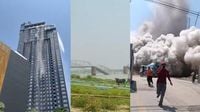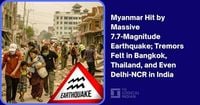A powerful earthquake with a magnitude of 7.7 struck Myanmar on March 28, 2025, at approximately 12:50 PM local time, sending shockwaves through the region and prompting widespread panic. The epicenter was located near Mandalay, Myanmar’s second-largest city, at a shallow depth of 10 kilometers (6.2 miles), according to the United States Geological Survey (USGS). Tremors were felt as far away as Bangkok, Thailand, and even Delhi-NCR in India, highlighting the quake's intensity and reach.
Eyewitness accounts from residents in Bangkok described a terrifying experience. “I was preparing lunch when suddenly my entire apartment began swaying like a boat on water,” recalled Supachai Wongthep, a Bangkok resident. “Pictures fell from walls, and I could hear screams from neighboring units. It lasted nearly a minute, but felt like an eternity.” In Chiang Mai, both tourists and locals rushed into the streets as buildings swayed visibly.
The earthquake's impact was felt strongly in Bangkok, where alarms blared in high-rise buildings, prompting frantic evacuations. Fraser Morton, a Scottish tourist, recounted the chaos: “All of a sudden, the whole building started moving. There was screaming, panic, people running in all directions.” In the aftermath, footage emerged showing the collapse of a multi-story building under construction in Bangkok, further emphasizing the quake's destructive potential.
Germany’s GFZ Centre for Geosciences confirmed the shallow depth of the quake, which amplified its intensity. The China Earthquake Networks Center (CENC) reported the tremor as magnitude 7.9, and earlier assessments had suggested varying magnitudes between 6.9 and 7.7. This inconsistency is common in the immediate aftermath of seismic events.
In Myanmar, the earthquake wreaked havoc across several regions. Reports indicated that part of the historic royal palace in Mandalay sustained damage, and a 90-year-old bridge in Sagaing collapsed. Roads in Naypyidaw buckled under the seismic waves, and significant structural damage was observed in various buildings. As of now, no official casualty figures have been released, but emergency response teams are mobilized to assess the situation.
Myanmar lies in a seismically active zone due to tectonic movements along the Indo-Australian Plate, making it particularly vulnerable to earthquakes. Dr. Michael Chen, a leading seismologist at the Asian Institute of Geological Studies, explained, “This earthquake occurred along the historically active fault zone that runs through Myanmar.” The region's geological context underscores the need for robust disaster preparedness measures.
In response to the earthquake, Myanmar’s government activated emergency protocols and dispatched teams to assess potential damage and provide assistance. Local authorities have advised residents to stay alert for aftershocks and to follow safety guidelines during such events. Meanwhile, Thailand’s disaster management agency is closely monitoring the situation and has implemented precautionary measures in high-rise buildings across Bangkok to ensure public safety.
Prime Minister Narendra Modi of India expressed concern over the situation, stating, “India stands ready to offer all possible assistance.” He urged Indian authorities to be on standby and to maintain communication with the governments of Myanmar and Thailand.
As the initial shockwaves began to settle, the focus shifted to the aftermath and recovery efforts. Emergency services across both countries are on high alert, and there are ongoing assessments of structural integrity in affected areas. Authorities are also monitoring for aftershocks, which could complicate recovery efforts.
Despite the fear and disruption, communities have demonstrated remarkable solidarity. Local restaurants provided free meals to displaced persons, and volunteers established temporary shelters for those affected. This human response serves as a powerful counterforce to the geological upheaval, showcasing the resilience of communities in the face of disaster.
As residents across Thailand and Myanmar remain vigilant, this earthquake serves as a stark reminder of the region’s vulnerability to natural disasters. The need for improved building codes and public education on emergency preparedness is more critical than ever. Experts emphasize that while advanced seismic monitoring systems have improved detection capabilities, predicting earthquakes remains a challenge.
In the wake of this seismic event, the question arises: how can communities better prepare for future disasters? The importance of fostering a culture of preparedness and resilience-building measures cannot be overstated. Governments must prioritize public safety initiatives, while individuals can contribute by educating themselves about emergency protocols and disaster response strategies.
As aftershocks continue to rattle the region, the focus will be on recovery and rebuilding efforts. The lessons learned from this earthquake could pave the way for a more resilient future, where communities are better equipped to handle the challenges posed by natural disasters.







